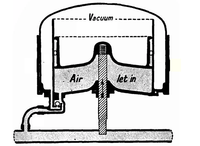Brakes
Various braking systems have been devised to reduce (break) the speed of trains, or to prevent rolling stock from moving off from a stationary position.
Some of these systems as used on the Ffestiniog and Welsh Highland Railways are listed below in rough chronological order.
Handbrake[edit]
Locomotives and some items of rolling stock have hand brake(s), which can be applied by the crew when that rolling stock is stationary. On older FR wagons the handbrake is often located on only one side of the vehicle. The handbrakes on most (but not all) passenger guard's vans have vacuum valves that prevent the continuous brake being released whilst the handbrake is applied.
Engine brake[edit]
A non-automatic brake applied to just the locomotive. Quicker than applying the continuous brakes. Should the engine brake fail, there is still the continuous automatic brake explained below.
Double Fairlies such as Little Wonder were fitted with the Chatellier Steam Break (sic). [1]
On the present day F&WHR most locomotives have steam brakes but some have independent vacuum brakes or are limited to a handbrake. The engine brake is often used to hold trains in place after they have been stopped on the automatic brake. This can result in the carriages rolling down hill a little way after the train has stopped.
Continuous brakes[edit]


Continuous brakes allow the brakes on all vehicles between the engine at the front and the rearmost connected vehicle to be applied together. This increases braking power. Automatic continuous brakes apply under a failure of the system (e.g. the train splitting). Automatic continuous brakes have been a requirement for passenger trains in the UK since the Regulation of Railways Act of 1889.
The most common continuous brakes are air and vacuum. These work by charging the entire braking system (i.e. both sides of the brake cylinder) to a pressure either above or below atmospheric pressure. When the air in the train pipe returns to atmospheric pressure a pressure differential is created across the brake cylinders and the brakes apply.
Vacuum[edit]
Vacuum brakes work below atmospheric pressure which is limited to about 17 psi (pounds per square inch) at sea level.
Vacuum brakes are used on the FR and WHR. Much of the equipment currently in use came from the Vale of Rheidol after they switched to air brakes or from South Africa.
More information: Wikipedia:Vacuum brake
Air[edit]
Air brakes operate above atmospheric pressure, so are not limited by it and typically operate at 60-70 psi.
Air brakes were used on the NWNGR and today can be found on the WHHR.
More information: Wikipedia:Railway air brake
Brake vans[edit]
Brake vans were traditionally coupled at the rear of trains, to secure the rear part of the train should a coupling fail, especially on rising gradients. Brake vans are made extra heavy so that the braking forced that they can apply is maximised, particularly in the era before the invention of continuous brakes. Present day F&WHR passenger trains are fully fitted and the brake van will commonly be found toward the middle of the train in the service car.
Fitted brake vans have a handle, or setter, that admits air to the train pipe and operates the continuous brake. The passenger alarm cords operate in a similar fashion but admit less air to the train pipe such that the brakes are not fully applied
Whistle codes[edit]
The engine driver can whistle to tell the brake van to apply or release the brakes.
Gallery[edit]
- Couplings
-
wagon 98 - handbrake is horizontal wheel on a vertical rod
-
engine Moelwyn - vacuum brake hose above coupler
-
vacuum brake hose (zoom)
See also[edit]
References[edit]
- ^ "THE RAILWAYS OF THE FUTURE". wikipedia:Illawarra Mercury. Vol. XVIII, , no. IV. New South Wales, Australia. 11 October 1872. p. 4. Retrieved 25 March 2017 – via National Library of Australia.
{{cite news}}: CS1 maint: extra punctuation (link)


